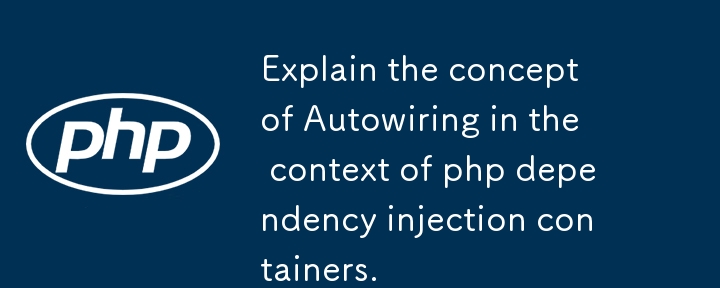 Backend Development
Backend Development
 PHP Tutorial
PHP Tutorial
 Explain the concept of Autowiring in the context of php dependency injection containers.
Explain the concept of Autowiring in the context of php dependency injection containers.
Explain the concept of Autowiring in the context of php dependency injection containers.
Jul 16, 2025 am 03:28 AMAutowiring in PHP DI containers automatically resolves and injects dependencies based on type hints, reducing boilerplate code. 1. It works by inspecting class constructors or injection points via reflection and instantiating required dependencies if resolvable. 2. It fails with primitive types, interfaces, or multiple implementations unless explicitly configured. 3. Best practices include using it for concrete classes, configuring interface bindings, avoiding runtime values, organizing container settings, and testing early for resolution issues.

Autowiring is a feature in PHP dependency injection (DI) containers that automatically resolves and injects dependencies without requiring explicit configuration for each class or service. It makes building and managing complex applications more efficient by reducing boilerplate code.

Here’s how it works and what to know when using it.
How Autowiring Resolves Dependencies Automatically
When you ask a DI container for an instance of a class, and autowiring is enabled, the container looks at the class's constructor (or other injection points like methods or properties) and tries to figure out what dependencies are needed based on type hints.

For example:
class Mailer {
public function __construct(private EmailService $emailService) {}
}If EmailService is already registered with the container or can also be resolved via autowiring, the container will automatically instantiate it and pass it into Mailer.

This means:
- You don’t have to manually define every dependency relationship.
- The container uses reflection to inspect class requirements.
- As long as all dependencies are resolvable, everything “just works.”
It’s especially useful in larger apps where manually wiring up every class becomes tedious.
When Autowiring Might Fail or Need Help
Autowiring isn’t magic — it has limits. Here are some common cases where it might not work out of the box:
Primitive types (like strings or booleans) in constructors: The container can’t guess what value you want unless you explicitly configure it.
Example:
public function __construct(private string $apiKey) {}Interfaces or abstract classes: If a dependency is an interface, the container doesn’t know which implementation to use unless told.
Multiple implementations: If two services implement the same interface, autowiring gets confused unless you specify which one to use.
- ? Use it for concrete classes with clearly type-hinted dependencies.
- ? Avoid relying on it for services that require runtime values (like config settings).
- ? Configure bindings for interfaces and abstract types so autowiring can resolve them.
- ? Keep your container configuration organized — even if you auto-wire most things, having a central place to tweak behavior helps.
- ? Test resolution early — sometimes circular dependencies or missing configs won’t show up until runtime.
In these situations, you’ll need to provide some configuration to guide the container.
Best Practices for Using Autowiring in PHP Projects
To make the most of autowiring without falling into pitfalls:
Many modern PHP frameworks like Symfony and Laravel use autowiring extensively under the hood, so understanding how it works helps you debug issues and write cleaner code.
That’s autowiring in a nutshell — it saves time but still needs a little guidance now and then.
The above is the detailed content of Explain the concept of Autowiring in the context of php dependency injection containers.. For more information, please follow other related articles on the PHP Chinese website!

Hot AI Tools

Undress AI Tool
Undress images for free

Undresser.AI Undress
AI-powered app for creating realistic nude photos

AI Clothes Remover
Online AI tool for removing clothes from photos.

Clothoff.io
AI clothes remover

Video Face Swap
Swap faces in any video effortlessly with our completely free AI face swap tool!

Hot Article

Hot Tools

Notepad++7.3.1
Easy-to-use and free code editor

SublimeText3 Chinese version
Chinese version, very easy to use

Zend Studio 13.0.1
Powerful PHP integrated development environment

Dreamweaver CS6
Visual web development tools

SublimeText3 Mac version
God-level code editing software (SublimeText3)

Hot Topics
 A step-by-step guide to understanding dependency injection in Angular
Dec 02, 2022 pm 09:14 PM
A step-by-step guide to understanding dependency injection in Angular
Dec 02, 2022 pm 09:14 PM
This article will take you through dependency injection, introduce the problems that dependency injection solves and its native writing method, and talk about Angular's dependency injection framework. I hope it will be helpful to you!
 How to use dependency injection (Dependency Injection) in the Phalcon framework
Jul 30, 2023 pm 09:03 PM
How to use dependency injection (Dependency Injection) in the Phalcon framework
Jul 30, 2023 pm 09:03 PM
Introduction to the method of using dependency injection (DependencyInjection) in the Phalcon framework: In modern software development, dependency injection (DependencyInjection) is a common design pattern aimed at improving the maintainability and testability of the code. As a fast and low-cost PHP framework, the Phalcon framework also supports the use of dependency injection to manage and organize application dependencies. This article will introduce you how to use the Phalcon framework
 Go Language: Dependency Injection Guide
Apr 07, 2024 pm 12:33 PM
Go Language: Dependency Injection Guide
Apr 07, 2024 pm 12:33 PM
Answer: In Go language, dependency injection can be implemented through interfaces and structures. Define an interface that describes the behavior of dependencies. Create a structure that implements this interface. Inject dependencies through interfaces as parameters in functions. Allows easy replacement of dependencies in testing or different scenarios.
 Dependency injection using JUnit unit testing framework
Apr 19, 2024 am 08:42 AM
Dependency injection using JUnit unit testing framework
Apr 19, 2024 am 08:42 AM
For testing dependency injection using JUnit, the summary is as follows: Use mock objects to create dependencies: @Mock annotation can create mock objects of dependencies. Set test data: The @Before method runs before each test method and is used to set test data. Configure mock behavior: The Mockito.when() method configures the expected behavior of the mock object. Verify results: assertEquals() asserts to check whether the actual results match the expected values. Practical application: You can use a dependency injection framework (such as Spring Framework) to inject dependencies, and verify the correctness of the injection and the normal operation of the code through JUnit unit testing.
 Explain the concept of Dependency Injection (DI) in PHP.
Apr 05, 2025 am 12:07 AM
Explain the concept of Dependency Injection (DI) in PHP.
Apr 05, 2025 am 12:07 AM
The core value of using dependency injection (DI) in PHP lies in the implementation of a loosely coupled system architecture. DI reduces direct dependencies between classes by providing dependencies externally, improving code testability and flexibility. When using DI, you can inject dependencies through constructors, set-point methods, or interfaces, and manage object lifecycles and dependencies in combination with IoC containers.
 Dependency injection pattern in Golang function parameter passing
Apr 14, 2024 am 10:15 AM
Dependency injection pattern in Golang function parameter passing
Apr 14, 2024 am 10:15 AM
In Go, the dependency injection (DI) mode is implemented through function parameter passing, including value passing and pointer passing. In the DI pattern, dependencies are usually passed as pointers to improve decoupling, reduce lock contention, and support testability. By using pointers, the function is decoupled from the concrete implementation because it only depends on the interface type. Pointer passing also reduces the overhead of passing large objects, thereby reducing lock contention. Additionally, DI pattern makes it easy to write unit tests for functions using DI pattern since dependencies can be easily mocked.
 PHP Dependency Injection Container: A Quick Start
May 13, 2025 am 12:11 AM
PHP Dependency Injection Container: A Quick Start
May 13, 2025 am 12:11 AM
APHPDependencyInjectionContainerisatoolthatmanagesclassdependencies,enhancingcodemodularity,testability,andmaintainability.Itactsasacentralhubforcreatingandinjectingdependencies,thusreducingtightcouplingandeasingunittesting.
 Dependency Injection in PHP: Code Examples for Beginners
May 14, 2025 am 12:08 AM
Dependency Injection in PHP: Code Examples for Beginners
May 14, 2025 am 12:08 AM
You should care about DependencyInjection(DI) because it makes your code clearer and easier to maintain. 1) DI makes it more modular by decoupling classes, 2) improves the convenience of testing and code flexibility, 3) Use DI containers to manage complex dependencies, but pay attention to performance impact and circular dependencies, 4) The best practice is to rely on abstract interfaces to achieve loose coupling.





